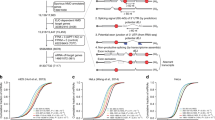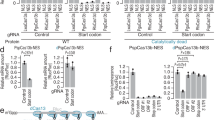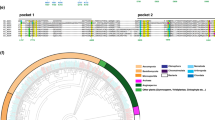Abstract
MicroRNAs (miRNAs) silence gene expression by binding 3′ untranslated regions of target mRNAs. Recent studies suggested silencing is achieved through either recruitment of eIF6, which prevents ribosome assembly, or displacement of eIF4E from the mRNA 5′ cap structure. Using Drosophila melanogaster cells, we show that eIF6 is not required for silencing. In contrast, silencing is abolished by mutating Argonaute 1 (AGO1) at two conserved phenylalanine residues predicted to mediate binding to the cap structure. Notably, we found these mutations also prevented AGO1 from interacting with GW182 and miRNAs, indicating that the essential role of these residues is unrelated to cap binding. Consistently, depleting GW182 or overexpressing its AGO1 binding domain relieved silencing of all reporters tested, including those lacking a poly(A) tail. Together, our findings show that miRNA function is effected by AGO1–GW182 complexes and the role of GW182 in silencing goes beyond promoting deadenylation.
This is a preview of subscription content, access via your institution
Access options
Subscribe to this journal
Receive 12 print issues and online access
$189.00 per year
only $15.75 per issue
Buy this article
- Purchase on Springer Link
- Instant access to full article PDF
Prices may be subject to local taxes which are calculated during checkout







Similar content being viewed by others
References
Bushati, N. & Cohen, S.M. MicroRNA functions. Annu. Rev. Cell Dev. Biol. 23, 175–205 (2007).
Nilsen, T.W. Mechanisms of microRNA-mediated gene regulation in animal cells. Trends Genet. 23, 243–249 (2007).
Pillai, R.S., Bhattacharyya, S.N. & Filipowicz, W. Repression of protein synthesis by miRNAs: how many mechanisms? Trends Cell Biol. 17, 118–126 (2007).
Eulalio, A., Huntzinger, E. & Izaurralde, E. Getting to the root of miRNA-mediated gene silencing. Cell 132, 9–14 (2008).
Chendrimada, T.P. et al. MicroRNA silencing through RISC recruitment of eIF6. Nature 447, 823–828 (2007).
Ceci, M. et al. Release of eIF6 (p27BBP) from the 60S subunit allows 80S ribosome assembly. Nature 426, 579–584 (2003).
Basu, U., Si, K., Warner, J.R. & Maitra, U. The Saccharomyces cerevisiae TIF6 gene encoding translation initiation factor 6 is required for 60S ribosomal subunit biogenesis. Mol. Cell. Biol. 21, 1453–1462 (2001).
Volta, V. et al. Sen34p depletion blocks tRNA splicing in vivo and delays rRNA processing. Biochem. Biophys. Res. Commun. 337, 89–94 (2005).
Kiriakidou, M. et al. An mRNA m(7)G Cap binding-like motif within human Ago2 represses translation. Cell 129, 1141–1151 (2007).
Marcotrigiano, J., Gingras, A.C., Sonenberg, N. & Burley, S.K. Cocrystal structure of the messenger RNA 5′ cap-binding protein (eIF4E) bound to 7-methyl-GDP. Cell 89, 951–961 (1997).
Bagga, S. et al. Regulation by let-7 and lin-4 miRNAs results in target mRNA degradation. Cell 122, 553–563 (2005).
Wu, L. & Belasco, J.G. Micro-RNA regulation of the mammalian lin-28 gene during neuronal differentiation of embryonal carcinoma cells. Mol. Cell. Biol. 25, 9198–9208 (2005).
Behm-Ansmant, I. et al. mRNA degradation by miRNAs and GW182 requires both CCR4:NOT deadenylase and DCP1:DCP2 decapping complexes. Genes Dev. 20, 1885–1898 (2006).
Behm-Ansmant, I., Rehwinkel, J. & Izaurralde, E. MicroRNAs silence gene expression by repressing protein expression and/or by promoting mRNA decay. Cold Spring Harb. Symp. Quant. Biol. 71, 523–530 (2006).
Giraldez, A.J. et al. Zebrafish MiR-430 promotes deadenylation and clearance of maternal mRNAs. Science 312, 75–79 (2006).
Mishima, Y. et al. Differential regulation of germline mRNAs in soma and germ cells by zebrafish miR-430. Curr. Biol. 16, 2135–2142 (2006).
Rehwinkel, J. et al. Genome-wide analysis of mRNAs regulated by Drosha and Argonaute proteins in Drosophila melanogaster. Mol. Cell. Biol. 26, 2965–2975 (2006).
Wu, L., Fan, J. & Belasco, J.G. MicroRNAs direct rapid deadenylation of mRNA. Proc. Natl. Acad. Sci. USA 103, 4034–4039 (2006).
Eulalio, A. et al. Target-specific requirements for enhancers of decapping in miRNA-mediated gene silencing. Genes Dev. 21, 2558–2570 (2007).
Rehwinkel, J., Behm-Ansmant, I., Gatfield, D. & Izaurralde, E. A crucial role for GW182 and the DCP1:DCP2 decapping complex in miRNA-mediated gene silencing. RNA 11, 1640–1647 (2005).
Pillai, R.S., Artus, C.G. & Filipowicz, W. Tethering of human AGO proteins to mRNA mimics the miRNA-mediated repression of protein synthesis. RNA 10, 1518–1525 (2004).
Grivna, S.T., Pyhtila, B. & Lin, H. MIWI associates with translational machinery and PIWI-interacting RNAs (piRNAs) in regulating spermatogenesis. Proc. Natl. Acad. Sci. USA 103, 13415–13420 (2006).
Ding, L., Spencer, A., Morita, K. & Han, M. The developmental timing regulator AIN-1 interacts with miRISCs and may target the argonaute protein ALG-1 to cytoplasmic P bodies in C. elegans. Mol. Cell 19, 437–447 (2005).
Jakymiw, A. et al. Disruption of GW bodies impairs mammalian RNA interference. Nat. Cell Biol. 7, 1167–1174 (2005).
Liu, J. et al. A role for the P-body component GW182 in microRNA function. Nat. Cell Biol. 7, 1261–1266 (2005).
Meister, G. et al. Identification of novel argonaute-associated proteins. Curr. Biol. 15, 2149–2155 (2005).
Chu, C.Y. & Rana, T.M. Translation repression in human cells by microRNA-induced gene silencing requires RCK/p54. PLoS Biol. 4, e210 (2006).
Zhang, L. et al. Systematic identification of C. elegans miRISC proteins, miRNAs, and mRNA targets by their interactions with GW182 proteins AIN-1 and AIN-2. Mol. Cell 28, 598–613 (2007).
Till, S. et al. A conserved motif in Argonaute-interacting proteins mediates functional interactions through the Argonaute PIWI domain. Nat. Struct. Mol. Biol. 14, 897–903 (2007).
Tolia, N.H. & Joshua-Tor, L. Slicer and the argonautes. Nat. Chem. Biol. 3, 36–43 (2007).
El-Shami, M. et al. Reiterated WG/GW motifs form functionally and evolutionarily conserved ARGONAUTE-binding platforms in RNAi-related components. Genes Dev. 21, 2539–2544 (2007).
Pillai, R.S. et al. Inhibition of translational initiation by let-7 microRNA in human cells. Science 309, 1573–1576 (2005).
Humphreys, D.T., Westman, B.J., Martin, D.I. & Preiss, T. MicroRNAs control translation initiation by inhibiting eukaryotic initiation factor 4E/cap and poly(A) tail function. Proc. Natl. Acad. Sci. USA 102, 16961–16966 (2005).
Wang, B., Love, T.M., Call, M.E., Doench, J.G. & Novina, C.D. Recapitulation of short RNA-directed translational gene silencing in vitro. Mol. Cell 22, 553–560 (2006).
Wakiyama, M., Takimoto, K., Ohara, O. & Yokoyama, S. Let-7 microRNA-mediated mRNA deadenylation and translational repression in a mammalian cell-free system. Genes Dev. 21, 1857–1862 (2007).
Acknowledgements
We are grateful to S.M. Cohen (Temasek Life Sciences Laboratory, Singapore) for providing miRNA expression vectors and the nerfin-1 and par-6 reporters, S. Dorner (University of Vienna) for generating reporters containing the histone H4 stem-loop structure, W. Filipowicz (Friedich Miescher Institute, Basel, Switzerland) for plasmids for tethering assays in human cells, and J. Pelletier (McGill University, Montreal) for his generous gift of hippuristanol. This study was supported by the Max Planck Society, by a grant from the Deutsche Forschungsgemeinschaft (DFG, FOR855) and by the Sixth Framework Programme of the European Commission through the SIROCCO Integrated Project LSHG-CT-2006-037900. A.E. and E.H. are recipients of fellowships from the Portuguese Foundation for Science and Technology and the European Molecular Biology Organization (EMBO), respectively.
Author information
Authors and Affiliations
Contributions
A.E. and E.H. performed all the experiments and analyzed the data. E.I. supervised the research and wrote the manuscript.
Corresponding author
Supplementary information
Supplementary Text and Figures
Supplementary Figures 1–6 and Supplementary Table 1 (PDF 1915 kb)
Rights and permissions
About this article
Cite this article
Eulalio, A., Huntzinger, E. & Izaurralde, E. GW182 interaction with Argonaute is essential for miRNA-mediated translational repression and mRNA decay. Nat Struct Mol Biol 15, 346–353 (2008). https://doi.org/10.1038/nsmb.1405
Received:
Accepted:
Published:
Issue Date:
DOI: https://doi.org/10.1038/nsmb.1405



